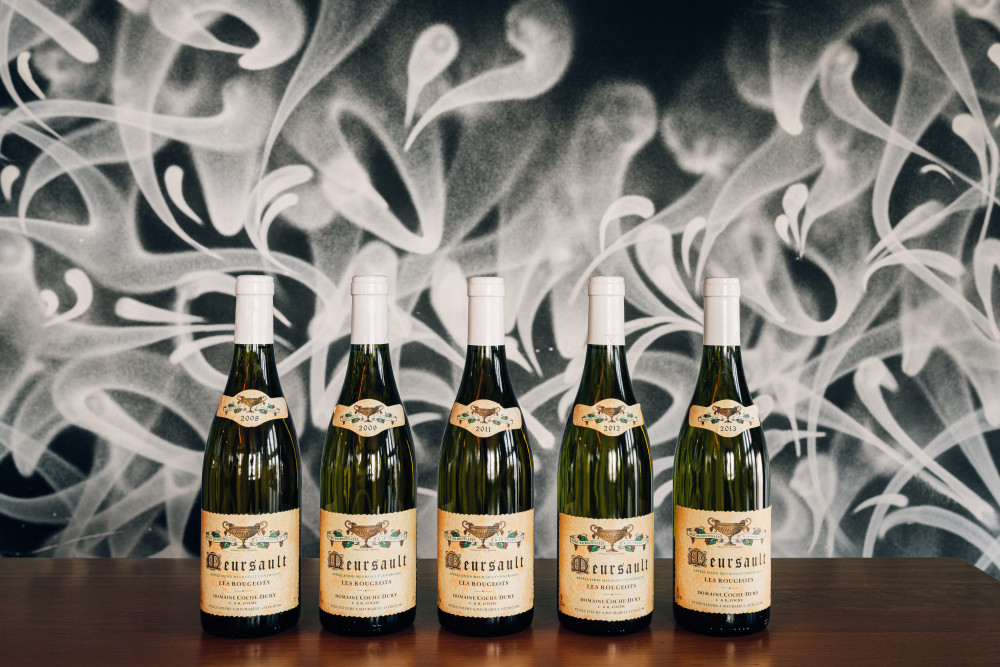Meursault
The Chardonnay hotspot in Burgundy. If you want to experience Burgundy Chardonnay in its true glory, you can't get around the wines from Meursault. The small appellation in the heart of the Côte d'Or can look back on an impressive winemaking tradition.
The best wines from Meursault
The Chardonnay hotspot in Burgundy. If you want to experience Burgundy Chardonnay in its true glory, you can't get around the wines from Meursault. The small appellation in the heart of the Côte d'Or can look back on an impressive winemaking tradition.
Grapes in wines from Meursault
Where does a Meursault come from?
Meursault is generally understood to be a Chardonnay from the Burgundy appellation of the same name, which can be found in the Côte de Beaune area of Côte d'Or. Welcome to the extremely fragmented Bourgogne! The vineyard here covers a good 350 hectares, nestled around the small town of Meursault. The climate here is temperate continental, with warm summers and cold winters. In spring, late frosts can still occur. Heavy rain in spring and autumn, as well as hail, regularly present challenges for winegrowers here. This is precisely why you should take a very close look at the vintage of a Meursault. Because these can be quite different. However, very good winegrowers know how to deal with the capricious weather.
Wine has been grown in Meursault since 1098, the year the Cistercians were founded and when they received their first vineyard as a gift from the Duke of Burgundy. The monks immediately recognised the region's potential, as it was already known then that the limestone-rich soil was ideal for viticulture.
What grapes are in a Meursault?
The white grape variety Chardonnay in particular thrives in Meursault. The climate and soils are simply ideal for it. However, there are also plants made from Pinot Blanc. Red wines made from Pinot Noir can also be found here. Smaller amounts of Pinot Lièbault and Pinot Gris may even be added to these. However, the appellation undoubtedly owes its prestige to the Chardonnay grape variety.
How is a Meursault made?
One reason why Meursault wines are so sought-after and considered to be particularly long-lasting is the ageing process in barriques. The 225-litre barrels ensure that the wine comes into contact with oxygen during the ageing process. In addition, it is still common practice for winemakers to age the wine on the fine lees. Sometimes even on the gross lees.
In both cases, the yeast sediment that forms in the barrels is stirred at regular intervals. This process is called bâtonnage. This is how the Meursault wines get their typical mellowness. It also enhances the complex depth and full body of the wine. In addition, barrel ageing and bâtonnage make a Meursault more long-lasting. Ten or more years are not a problem for a wine like this, especially in the premier cru range.
What makes a Meursault wine so special?
Whereby longevity is not the only special feature of Meursault wines. Due to its complexity and intensity, it is one of the best Chardonnays in the world – and is considered the epitome of a white Burgundy. It also stands for enjoyment par excellence. A saying in the community goes: ‘Only those who drink Meursault will never become drunkards’.
In addition, the ownership structure in Meursault is extremely fragmented, even by Burgundy standards. Hardly any winemaker owns more than five hectares of vineyards. In most cases, it is even less. This is the result of direct succession, which has been in force in Burgundy for centuries. One final reason is the limited availability of Meursault wines. The growths are in high demand all over the world. Demand significantly exceeds availability. For this reason, Meursaults are generally not a bargain.
Wine producers
Which Meursault Crus are there?
As is usual everywhere in France, there are of course also Crus in Meursault. In other words, world-famous single vineyards. In fact, Meursault doesn't have a single Grand Cru. However, the appellation boasts 18 Premier Crus, the most important of which are Bouchères, Charmes, Genevrières, Goutte d'Or, Poruzot, Perrières, Pièce sous le Bois, Poruzots, Santenots and Sous le Dos d'Ane.
Volnay-Santenots Premier Cru is a little special. This cru was given its status as early as 1924 and is reserved for red wine. The name might suggest that the vineyards are in the neighbouring village of Volnay, but in fact they belong to Meursault. Alternative appellations are Meursault-Blagny Premier Cru for white wines from certain sites around Blagny, Meursault-Côte de Beaune for red wines only, and Meursault-Santenots for white wines from Premier Cru sites in certain areas of Volnay-Santenots. Well-known Meursault producers are Caroline Parent, Coche Dury, Michelot, Joseph Drouhin, Jadot and Laurent Ponsot.
What does a Meursault taste like?
It is not really possible to generalise about the taste of Meursault wines. The location, grape variety clone, harvest time, vinification and, of course, the ageing process can lead to very different aromas and flavours. However, what is typical of a Meursault is the mineral touch that is present in all plants. The same applies to the citrus notes. You can also often find hints of honeydew melon, pineapple and pear, as well as vanilla, acacia flowers and white almonds.
Due to its depth and complexity, a Meursault is a very good food companion. It goes very well with fish in creamy sauces. It is also an excellent accompaniment to delicate mushroom and pumpkin dishes. Be inspired by the Meursault selection at Best of Wines.
Other Appellations



